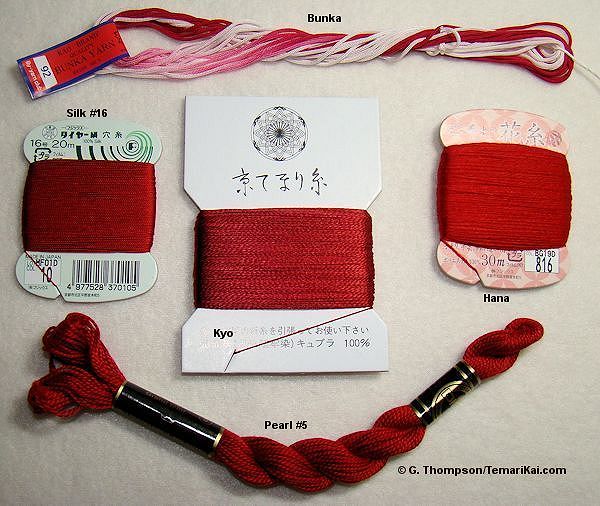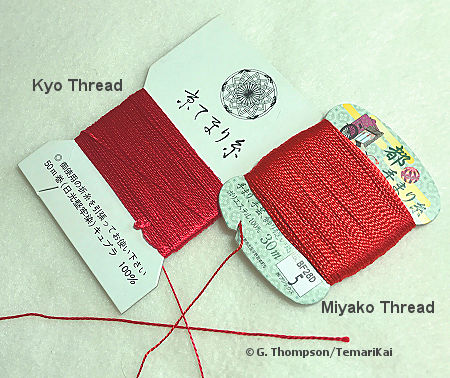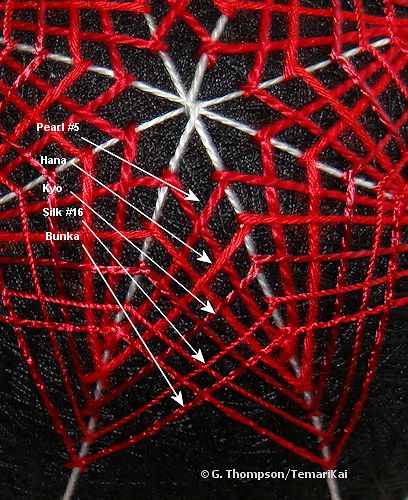Stitching Threads used in Temari
Virtually anything that can be threaded into a needle and pulled through a mari can be used for temari stitching (and believe me, through the years on TalkTemari we've had some folks that have tried just about anything), There are some however that are the most appropriate and applicable to temari. Historically, flax, linen and silk seem to be the traditional fibers; even today silk would be the fiber of choice but both availability and price keep it on the "special occasion" list (in addition to it needing some special handling). There are is an assortment of threads that are commonly used in modern temari - though this is certainly not meant to be an all-inclusive list.


February 2017: Sadly, Kyo thread from Japan is no longer available (the company has closed). However, Miyako (a polyester thread manufactured from by Fujix) thread is very similar in both gauge and sheen as can be seen in the photo above. It's not recommended to begin substituting Miyako for Kyo within a project as then the differences will be noticeable, but otherwise they can be considered almost equivalent in use and appearance. Miyako comes on 30 meter cards rather than 50, so plan accordingly but there is color consistency so dye lots are no longer a worry.
The photo above shows the threads most often seen in temari-making. Perle (or pearl - either is acceptable) cotton #5 is probably the most common, and also the easiest to obtain in most places. It's manufactured under various brand names from several countries. It is a 2-ply, twisted, high sheen thread, which is not divisible or pliable (able to be separated). Pearl cotton also comes in different sizes; the lower the number the thicker the thread. The most common sizes used in temari are 3, 5, and 8. It's packaged as skeins or balls for embroidery use, comes in a wide range of colors, and can also be had in variegated & over-dyed combinations. Pearl cotton #5 is the most recommended for beginners.
All of the other threads are from Japan. Hana thread is a polyester thread, though it looks & handles more like cotton with soft drape and a matte finish. It is a 5-strand twisted cord, not polished, and not meant to be divisible. It's just a tad finer than pearl cotton, and is meant to be used as is off the card. It's often recommended in Japan for beginners since it tends to not slip while stitching. It gives a more rustic, muted look to the finished piece with its soft appearance. Kyo thread is a rayon thread, 2-ply twisted cord (not divisible); very lustrous and shiny and due to the synthetic base the colors are very intense. It is closer to a Pearl #8 in size, is a bit slippery to stitch with and will catch on rough skin or nails, but with a little care works up just fine with stunning results. Silk #16 is a tight twist thread, often seeing use in hand-sewing as buttonhole thread. It is commonly used for yubinuki, but does give impressive results on temari as well. Being a finer thread, and silk, it does require some special handling (check out the silk page of tips) but gives high resolution in color and design. Bunka is a chained thread, used in several needlework technqiues and usually is unchained to a degree when used for temari making. The amount of tension used when stitching can give varying texture effects - refer to the bunka page for more info.
Stranded floss is another common thread (not shown in the photo) - but it requires some special handling for its use. It's not designed to be used by simply cutting a length from the packaged skein - the plies need to be separated and relaid with each other, according to the thickness of the stitching being done. Check out the page on stranded floss for help on this.
 The photo to
the right shows a sample of stitching with each of the above threads.
The sample is worked on a 29cm mari, and is marked in Pearl Cotton #8.
The threads are, in order from the top down, Pearl #5, Hana, Kyo, Silk
#16, and unchained Bunk pulled smooth. With the threads shown as single
strand as they appear when worked, you can see the differences in not
only size but texture. Pearl cotton is sharply defined in addition to
having a sheen due to its manufacturing process. Hana has a softer
appearance and drape. Kyo again has a sharp definition. Silk #16 is also
sharply defined, and also note that the thread is twisted in the
opposite direction from the others. This is often a characteristic of
many silks and one of the special conditions to pay attention to when
working with it. Bunka retains it's chained look even as it is
"unchained" to be worked with, as the original process is a multiple of
4. If bunka is used with looser tension when stitching, it can result in
a very soft, fluffy appearance similar to chenille.
The photo to
the right shows a sample of stitching with each of the above threads.
The sample is worked on a 29cm mari, and is marked in Pearl Cotton #8.
The threads are, in order from the top down, Pearl #5, Hana, Kyo, Silk
#16, and unchained Bunk pulled smooth. With the threads shown as single
strand as they appear when worked, you can see the differences in not
only size but texture. Pearl cotton is sharply defined in addition to
having a sheen due to its manufacturing process. Hana has a softer
appearance and drape. Kyo again has a sharp definition. Silk #16 is also
sharply defined, and also note that the thread is twisted in the
opposite direction from the others. This is often a characteristic of
many silks and one of the special conditions to pay attention to when
working with it. Bunka retains it's chained look even as it is
"unchained" to be worked with, as the original process is a multiple of
4. If bunka is used with looser tension when stitching, it can result in
a very soft, fluffy appearance similar to chenille.Pearl cotton (and stranded floss) can be easily obtained in most areas, either locally or by mail/web order. An inexpensive substitute for pearl cotton on the market these days is something called "craft thread" - it's a lesser-quality pearl cotton but can be very serviceable for beginners and children. Silk pearl (and floss) is also available and can provide happy results, but again silk require some special handling and might not be the best for beginners.
There are differences working in natural fibers versus synthetics. Natural fiber threads tend to have some loft - they compress as they are pulled through the stitching surface but then rebound. That is why it's a bit easier to do an all-over design with pearl cotton than a synthetic thread. There is a wee bit of wiggle room with pearl, not with synthetics/rayon. Rayon is firm - it doesn't compress and rebound, so what you see is what you get. You must be precise in laying threads and taking the stitch to keep them there in order to fill space - it doesn't let you cheat. Natural threads usually have some "pill" - a bit of fuzz - on them. Synthetics are squeaky clean and smooth. That clean and smooth bit is one of the things that gives them the sheen. The more pill, the less smooth and the more matte the appearance. If you want to get technical, synthetics have a much different coefficeint of friction - whether threads or anything - and is why they are smooth and slippery compared to natural substances. This is why rayon threads slide through the mari so easily. But, with that outer surface being so smooth, there is no "fill factor" over the absolute value of the gauge of the thread.
Synthetics/rayon tend to be a bit stiffer. If you have ever worked with Omega Nylon, you know what stiff is. It's a gorgeous thread when it comes to color and sheen but it really needs to be finger pressed on every corner and point. This is often true with synthetics in general - they just don't have the soft "hand" and "drape" that natural fibers do. The few synthetics that do are well into the high-end. And, even if there is a bit of softness, there is often a pretty solid "memory" - if you work with rayon floss at all, you know that many times you keep a little moist sponge to wipe the thread on before using to remove the "kinks" from it being stored on a card or bobbin. You'll see the same "fold lines" in the Kyo. Depending on the detail of the design and how things fall, relaxing the creases in Kyo sometimes is needed (not too often). If you have worked with bunka and you want it really smooth, you wipe the length with a moist towel or sponge (this is not soaking it - you use it immediately). Natural fibers usually do not take on the kinks or creases at all or to such an extent and rarely if ever need to be smoothed.
Substituting other threads such as crochet cotton, tapestry yarn, etc can have mixed results. It can be fun to experiment with less-than-common fibers (as long as you are also prepared for perhaps not so happy results sometimes), but wouldn't be recommended for beginners. There is a myriad of fibers out there today, ranging from traditional to very abstract. They can be taken advantage of very well, especially in more free-form surface embroidery accents in temari designs.
The Japanese threads are most easily available on Ai's Store (I have no business connection with Ai); TalkTemari members would do best to participate in the list group orders several times a year.
This
is a TemariKai.com Printable Page; © 2017, all rights reserved.
Right click to print one copy for personal use.
Last updated 02/2017 © 1998 - 2017 TemariKai.com, G. Thompson/PuffinStuff, Inc.
